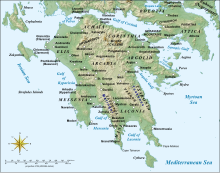Barony of Karytaina
| Barony of Karytaina | |
|---|---|
| Barony of the Principality of Achaea | |
| 1209–1275/89 | |
 Map of the Peloponnese with its principal locations during the late Middle Ages | |
| Capital | Karytaina |
| Area | |
| • Coordinates | 37°29′N 22°3′E / 37.483°N 22.050°E |
| • Type | Feudal lordship |
| Historical era | Middle Ages |
• Established | 1209 |
• Return to the princely domain | 1275/89 |
The Barony of Karytaina or of Skorta was a medieval Frankish fiefdom of the Principality of Achaea, located in the Peloponnese peninsula in Greece, centred on the town of Karytaina (Greek: Καρύταινα; French: Caraintaine; Italian: Caritena) in the mountainous region known as Skorta.[1]
History
The Barony of Karytaina was established ca. 1209, after the conquest of the
Elis.[4]
The first baron was probably
William II of Villehardouin, and his absence from the Peloponnese in 1263–65 without authorization, as required by Achaean feudal law, he was dispossessed twice, but was each time pardoned and restored to the barony, albeit now no longer by inalienable right of conquest, but as a gift from the Prince. Geoffrey had no heirs, and on his death in 1275 the barony was split: one half remained with his widow, Isabella de la Roche, and the other reverted to the Prince's domain.[6] Two pretenders to the barony appeared a few years later: a certain John Pestel, and Geoffrey's nephew, Geoffrey the Younger, who after much persistence managed to obtain the fief of Moraina.[7]
Isabella married a second time, to
John of Gravina tried to recover the fortress, but without success.[11]
Coinage
Along with the
Barony of Damala, Karytaina is the sole barony of Achaea known to have minted coinage in its own name: a series of billon deniers issued in the 1290s by Helena Angelina Komnene, second wife and widow of Hugh of Brienne. These were marked with the legends HELENA D[E]I GRA[TIA] and CLARICTIA S[EMI] F[EUDI DOMINA], apparently in claim of her husband's half-barony.[12] As A. Bon points out, however, this issue was struck with CLARICTIA and not CARITENA, and at any rate was made in her capacity as regent for the Duchy of Athens rather than as lady of Karytaina.[13]
References
- ^ Bon (1969), pp. 105, 367
- ^ Miller (1921), pp. 71–72
- ^ Bon (1969), pp. 105, 366–367
- ^ Bon (1969), pp. 105, 365–366
- ^ Bon (1969), pp. 105, 367
- ^ Bon (1969), pp. 105–106, 367–368
- ^ Bon (1969), pp. 148, 392, 700
- ^ Bon (1969), pp. 149, 150, 160, 368
- ^ Bon (1969), pp. 161, 368
- ^ Bon (1969), pp. 179, 189, 368
- ^ Bon (1969), pp. 202, 205, 368
- ^ Mallo, Preston & Seltman (1994), pp. 374–375
- ^ Bon (1969), p. 87 note 4, 701
Sources
- Bon, Antoine (1969). La Morée franque. Recherches historiques, topographiques et archéologiques sur la principauté d'Achaïe [The Frankish Morea. Historical, Topographic and Archaeological Studies on the Principality of Achaea] (in French). Paris: De Boccard. OCLC 869621129.
- Evergates, Theodore (1994). "The Origin of the Lords of Karytaina in the Frankish Morea". Medieval Prosopography. 15 (1): 81–113. JSTOR 44947037.
- Mallo, Alex G.; Preston, Irene Fraley; Seltman, A. J. (1994). Coins of the Crusader States, 1098–1291: including the Kingdom of Jerusalem and its vassal states of Syria and Palestine, the Lusignan Kingdom of Cyprus (1192–1489), and the Latin Empire of Constantinople and its vassal states of Greece and the Archipelago. New York: Attic Books Ltd. ISBN 0-915018-50-0.
- OCLC 457893641.
